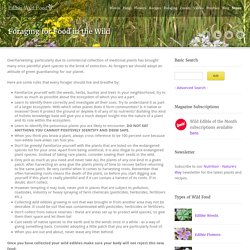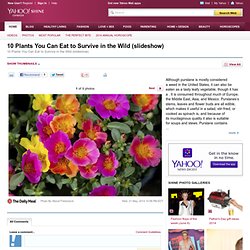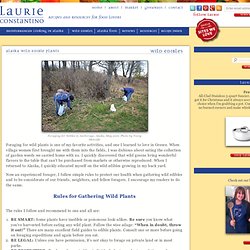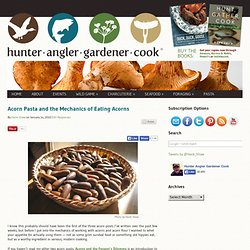

Foraged and Found Recipes. Foraging: 52 Wild Plants You Can Eat. Here are a few common North American goodies that are safe to eat if you find yourself stuck in the wild: Blackberries:

Foraging for Food in the Wild. Overharvesting, particularly due to commercial collection of medicinal plants has brought many once plentiful plant species to the brink of extinction.

As foragers we should adopt an attitude of green guardianship for our planet. Here are some rules that every forager should live and breathe by: Familiarize yourself with the weeds, herbs, bushes and trees in your neighborhood, try to learn as much as possible about the ecosystem of which you are a part. Learn to identify them correctly and investigate all their uses. Try to understand it as part of a larger ecosystem. Once you have collected your wild edibles make sure your body will not reject this new food: First, rinse or wash the parts of the plant you are using. Foraging wild food with 12 easy wild foods that anyone can harvest. Nature's Superfood on your doorstep In days gone by, wild foods were all we had, that used to be staple diet necessary for human health and survival.

Often full of natural medicinal benefits, wild foods often saved lives in times of famine, war and ill health. It’s a little bizarre to contemplate how radically removed from nature we have actually become. As intensive farming methods and consumerism came into being, our general attunement to nature fell away, and our knowledge thereof has somewhat dwindled. Increasing food prices, uncertain times of global change and decreasing food availability has invited more and more people to contemplate alternative ways of finding food by foraging. Full of nutritional goodness. The Fantastic Four – 4 Essential Wild Edible Plants that May Just Save Your Life.
Did you realize that knowing just 4 wild edible plants could one day save your life?

If there were any four categories of plants that I would recommend all people to know how to use and identify it would be these: Grass, Oak, Pine, and Cattail. For the knowledgeable survivor, knowing just these four plants can make the difference between life and death if stranded in the wilds – for each one is an excellent food source which can sustain you until help arrives. Edible weeds/wild plants. Weeding Out and Dining In: Foraging with Tama Matsuoka Wong. 10 Plants You Can Eat to Survive in the Wild (slideshow) Although purslane is mostly considered a weed in the United States, it can also be eaten as a tasty leafy vegetable, though it has a .

It is consumed throughout much of Europe, the Middle East, Asia, and Mexico. Purslanes’s stems, leaves and flower buds are all edible, which makes it useful in a salad, stir-fried, or cooked as spinach is, and because of its mucilaginous quality it also is suitable for soups and stews. Purslane contains ... more Although purslane is mostly considered a weed in the United States, it can also be eaten as a tasty leafy vegetable, though it has a . Less. Foraging. Wild Edible Plants In N. America. Foraging for Nettles in Anchorage, Alaska, May 2010.

Photo by Teeny Metcalfe Foraging for wild plants is one of my favorite activities, and one I learned to love in Greece. When village women first brought me with them into the fields, I was dubious about eating the collection of garden weeds we carried home with us. I quickly discovered that wild greens bring wonderful flavors to the table that can’t be purchased from markets or otherwise reproduced. Plant Search By US State. Wild mushroom foraging guide online. Foraging Food Types. Wild Mussels! How to Clean & Debeard. Jeeps McGee, my trusty vehicle, starts up with a gutsy roar.

The performance exhaust shakes me with thunderous throaty vibrations. My coffee cup perched precariously on the dash spills while disco competes for attention on a station I don’t remember ever having set (was I really listening to this last night? Yikes!). My overnight duffle is happily absorbing the jus de chaussette I was very much looking forward to. Some happy New Year this is! After an onslaught of holiday parties, I am throwing in the cocktail dress and pulling on the workboots. How to Collect, Process and Store Acorns and Acorn Flour. Photo by Hank Shaw I know this probably should have been the first of the three acorn posts I’ve written over the past few weeks, but before I got into the mechanics of working with acorns and acorn flour I wanted to whet your appetite for actually using them — not as some grim survival food or something old hippies eat, but as a worthy ingredient in serious, modern cooking.

If you haven’t read my other two acorn posts, Acorns and the Forager’s Dilemma is an introduction to the use of acorns; the Forager’s Dilemma is, in a word, starch. Starch (carbohydrates) is the toughest thing to forage for, and is a primary reason why humans settled down 10,000 years ago to grow grain. Next I wrote about an interesting Acorn Honey Cake I’d made and how various world cultures have traditionally used acorns, cultures ranging from Korea to Japan to the Native Americans, Europeans and North Africans.
COLLECTING ACORNS First you need to get yourself a supply of acorns. A word on worms. What does it mean? Foraging for Miner's Lettuce, a World-Class Salad Green. Photo by Hank Shaw Here in Northern California, our spring has already begun.

Manzanita is in flower, and the almonds and wild plums are in full bloom. Everything that’s not concrete is green, greener than anything you can imagine. Ireland green. It is the Time of Salads. And no wild salad green is more important than miner’s lettuce, Claytonia perfoliata. I wonder if they just didn’t recognize the plant in its natural setting? Undeservedly so. According to a study in the Journal of the American Dietetic Association, 100 grams of miner’s lettuce — about the size of a decent salad — contains a third of your daily requirement of Vitamin C, 22 percent of the Vitamin A, and 10 percent of the iron. 19 wild plants.
Wild Foods in Oregon: 5 Tips for Edible Foraging. Previous image Next image Dr.

John Kallas of Wild Food Adventures. Foraging the wild for plants and stuff to eat. Field guide to foraging in the Northwest. Admit it. You want to be a forager, too. Laurie Constantino. Cold Soup for Hot Summer Days: Green Gazpacho When days are long and the sun shining, there’s no better place than Alaska. How to Harvest Spruce Tips with Recipes for Using Spruce Tips (or Pine Tips or Fir Tips) Spruce tips are one of the more unusual, least used, and tastiest wild edibles in Alaska. Over the last few weeks, I picked a bucketful and had a great time playing and experimenting with them. (I used spruce tips because they grow in my yard. Just another Day on the Farm. There are folks that consider these weeds as they freely grow in my local area, so I would consider them a “wild” harvestable food. The perk of this, is that you should be able to find yourself some of these for free to transpant back into your own yard and garden. Warning: These hardy plants spread rapidly, and so plant them where you can mow around the edges or in a area that you don’t mind if they take over as a lovely ground cover.
They do well in shady areas under tree’s but are tough enough to handle most conditions. As with all edible flowers, use ONLY varieties that have been organically grown and never sprayed – and do not eat the African violets, they are not the same as wild Violets. Leaves are heart shaped attached to long petioles, Five petaled purple or blue flower with white centers.